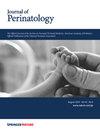The coagulation system of extremely preterm infants: influence of perinatal risk factors on coagulation
IF 2.4
3区 医学
Q2 OBSTETRICS & GYNECOLOGY
引用次数: 28
Abstract
Little is known about the influence of preterm delivery and perinatal risk factors on development and expression of the coagulation system in extremely preterm infants. The objective of this study was to determine reference values for the components of the coagulation system at the first day of life in extremely preterm infants. Components of the coagulation system were examined retrospectively in 132 extremely preterm infants. Patients were grouped according to clinical criteria for preterm delivery: group A: maternal indication; group B: uteroplacental dysfunction; group C: systemic inflammation. Levels of coagulation factors VII and X rose with increasing gestational age, whereas fibrinogen and coagulation factors II, V and VIII remained constant. Levels of factors V and VIII were higher than those of vitamin K-dependent factors. If preterm delivery was caused by placental disorder (group B) or chorioamnionitis (group C), levels of factor II, VIII and X were significantly lower, whereas factor V and VII levels did not differ. In group C fibrinogen levels in group C were higher compared with group A. Identification of perinatal risk factors may help to define patients at risk of bleeding disorders.极早产儿的凝血系统:围产期风险因素对凝血的影响
人们对早产和围产期风险因素对极早产儿凝血系统的发育和表达的影响知之甚少。本研究旨在确定极早产儿出生后第一天凝血系统成分的参考值。对 132 名极度早产儿的凝血系统成分进行了回顾性检查。根据早产的临床标准对患者进行分组:A 组:母体指征;B 组:子宫胎盘功能障碍;C 组:全身炎症。凝血因子 VII 和 X 的水平随着胎龄的增加而升高,而纤维蛋白原和凝血因子 II、V 和 VIII 的水平则保持不变。因子 V 和 VIII 的水平高于依赖维生素 K 的因子。如果早产是由胎盘功能紊乱(B 组)或绒毛膜羊膜炎(C 组)引起的,则因子 II、VIII 和 X 的水平显著降低,而因子 V 和 VII 的水平则没有差异。与 A 组相比,C 组的纤维蛋白原水平较高。
本文章由计算机程序翻译,如有差异,请以英文原文为准。
求助全文
约1分钟内获得全文
求助全文
来源期刊

Journal of Perinatology
医学-妇产科学
CiteScore
5.40
自引率
6.90%
发文量
284
审稿时长
3-8 weeks
期刊介绍:
The Journal of Perinatology provides members of the perinatal/neonatal healthcare team with original information pertinent to improving maternal/fetal and neonatal care. We publish peer-reviewed clinical research articles, state-of-the art reviews, comments, quality improvement reports, and letters to the editor. Articles published in the Journal of Perinatology embrace the full scope of the specialty, including clinical, professional, political, administrative and educational aspects. The Journal also explores legal and ethical issues, neonatal technology and product development.
The Journal’s audience includes all those that participate in perinatal/neonatal care, including, but not limited to neonatologists, perinatologists, perinatal epidemiologists, pediatricians and pediatric subspecialists, surgeons, neonatal and perinatal nurses, respiratory therapists, pharmacists, social workers, dieticians, speech and hearing experts, other allied health professionals, as well as subspecialists who participate in patient care including radiologists, laboratory medicine and pathologists.
 求助内容:
求助内容: 应助结果提醒方式:
应助结果提醒方式:


